Thanks Dave! You’re right, many examples, but few with a complete or even somewhat accurate description!
You are using an out of date browser. It may not display this or other websites correctly.
You should upgrade or use an alternative browser.
You should upgrade or use an alternative browser.
Building a Ferguson Rifle from Rifle Shoppe Part Set
- Thread starter dave_person
- Start date

Help Support Muzzleloading Forum:
This site may earn a commission from merchant affiliate
links, including eBay, Amazon, and others.
- Joined
- Nov 26, 2005
- Messages
- 5,282
- Reaction score
- 11,263
Hi Guys,
It has been a long time since I posted on this project. I had to put it aside for a while to get work done with harder deadlines but am back at it full time now. It is almost done. I wanted to discuss the official markings applied to these ordnance issued rifles. I have all the stamps, with one exception, which I will describe, but they are not mindlessly easy to apply. So I will describe the marks and how I did them.
The breech of the barrel should have an array of marks. Keep in mind, I am discussing the ordnance issued guns NOT the privately made versions. First there are stamps for the gun makers. They were Mathias Barkley & John Whatley (partners), Samuel Galton Jr, Benjamin Willets, and William Grice, all of Birmingham. So I had a choice and my apprentice, Maria, and I chose Grice because we like his work since I own a beautiful original lock by him. So we stamped "WG" on the left side of the barrel. Then we added a crown over "PF" just in front of the barrel tang indicating "Patrick Ferguson" . While I have a stamp for the crown and scepters government proof mark, it does not work well in modern barrel steel. So we stamped the mark on the left side of the barrel and then I engraved it deeper. Then I stamped it again. That worked. I don't have the proper stamp for the government view mark on the right side of the barrel so I used a close match, the government ownership mark. I stamped it lightly so it just looks like a poor stamping and is a little vague hiding the differences.
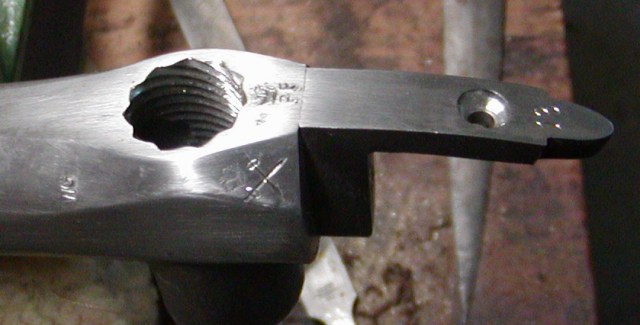
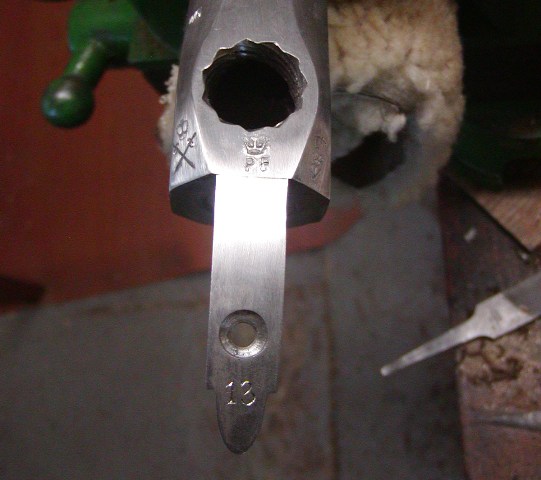
Also note the number "13" on the barrel tang. There were 100 rifles made and I asked the owner for his favorite number between 1 and 100. He chose "13", so I engraved that on the tang. These rifles were "thrice" engraved to identify key components fitted to the unique gun. So that number was engraved on the trigger guard bow, barrel tang, and butt plate return. I've made a study of the fonts used for these markings and can reproduce them exactly as they should appear.
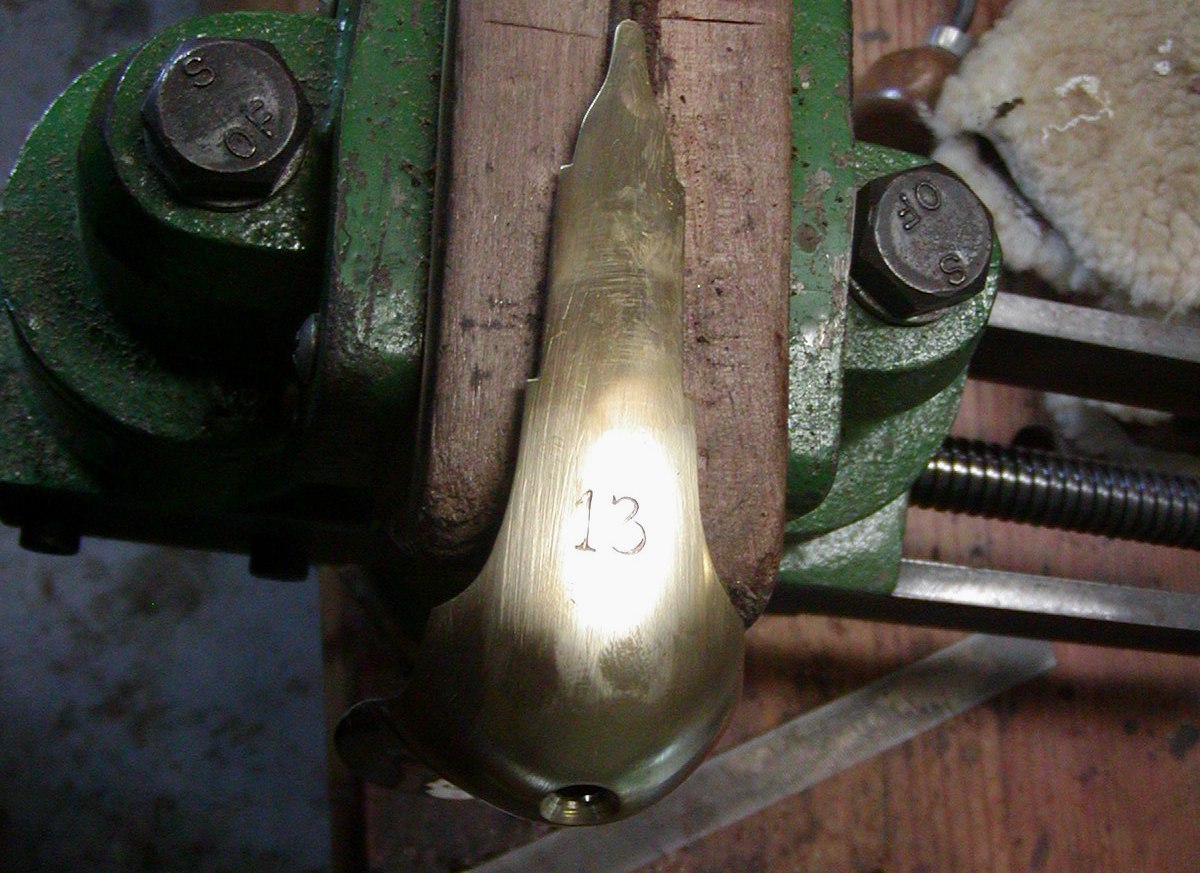

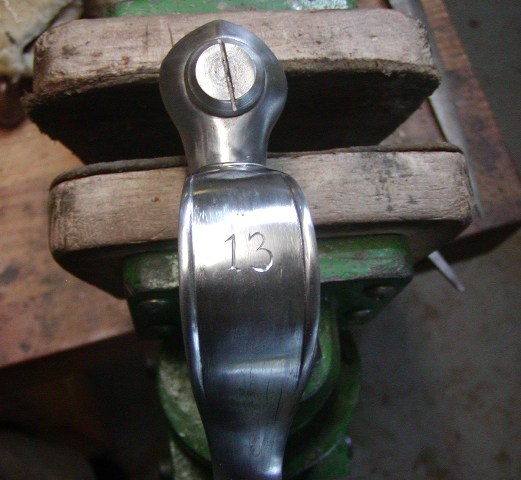
Finally, on British military stocks there are usually an array of inspection marks. That was not the case for the Fergusons. They were produced largely at the discretion of the makers and there are no inspection marks on the stocks except the store keeper's mark shown here on the butt of the stock.
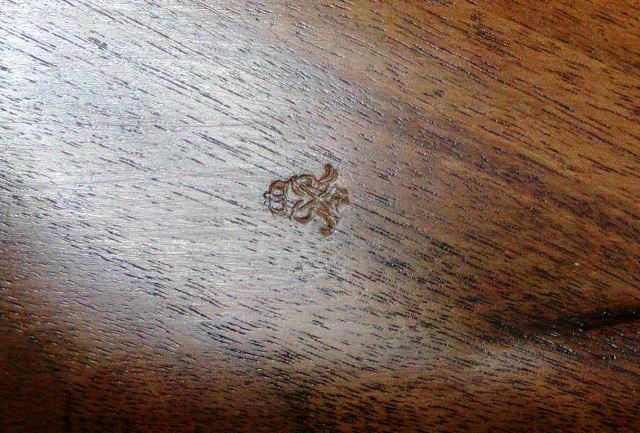
The lack of inspector's marks suggests the rush to production these guns experienced. Indeed, even the locks did not have government ownership stamps and the crown over "GR" was much more crudely engraved than the Rifle Shoppe castings.
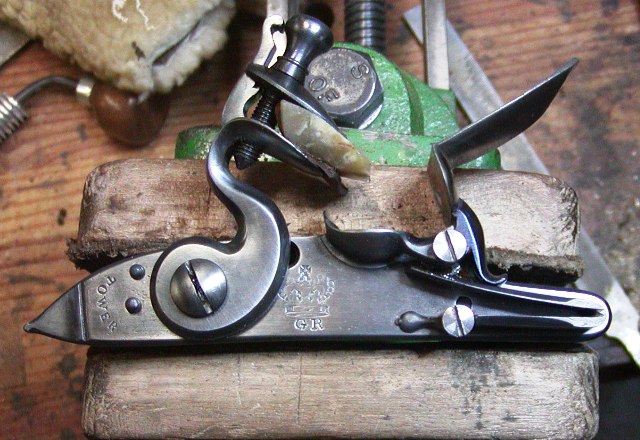
dave
It has been a long time since I posted on this project. I had to put it aside for a while to get work done with harder deadlines but am back at it full time now. It is almost done. I wanted to discuss the official markings applied to these ordnance issued rifles. I have all the stamps, with one exception, which I will describe, but they are not mindlessly easy to apply. So I will describe the marks and how I did them.
The breech of the barrel should have an array of marks. Keep in mind, I am discussing the ordnance issued guns NOT the privately made versions. First there are stamps for the gun makers. They were Mathias Barkley & John Whatley (partners), Samuel Galton Jr, Benjamin Willets, and William Grice, all of Birmingham. So I had a choice and my apprentice, Maria, and I chose Grice because we like his work since I own a beautiful original lock by him. So we stamped "WG" on the left side of the barrel. Then we added a crown over "PF" just in front of the barrel tang indicating "Patrick Ferguson" . While I have a stamp for the crown and scepters government proof mark, it does not work well in modern barrel steel. So we stamped the mark on the left side of the barrel and then I engraved it deeper. Then I stamped it again. That worked. I don't have the proper stamp for the government view mark on the right side of the barrel so I used a close match, the government ownership mark. I stamped it lightly so it just looks like a poor stamping and is a little vague hiding the differences.


Also note the number "13" on the barrel tang. There were 100 rifles made and I asked the owner for his favorite number between 1 and 100. He chose "13", so I engraved that on the tang. These rifles were "thrice" engraved to identify key components fitted to the unique gun. So that number was engraved on the trigger guard bow, barrel tang, and butt plate return. I've made a study of the fonts used for these markings and can reproduce them exactly as they should appear.



Finally, on British military stocks there are usually an array of inspection marks. That was not the case for the Fergusons. They were produced largely at the discretion of the makers and there are no inspection marks on the stocks except the store keeper's mark shown here on the butt of the stock.

The lack of inspector's marks suggests the rush to production these guns experienced. Indeed, even the locks did not have government ownership stamps and the crown over "GR" was much more crudely engraved than the Rifle Shoppe castings.

dave
As they say, The devil is in the details. Looks like the devil was busy!
Felix the Cat
40 Cal
A couple of things...
Firstly I have found another Ferguson in Edinburgh Castle. It is in the Museum of the Royal Scots Dragoon Guards, which are the successors to the North British Dragoons, Ferguson's original regiment. The gun is a military pattern rather than a civil one, but I need to check the markings and get a better look at it.. I have some contacts with the Regiment, so we will see...
As to Dave's stamping about.. I cannot but admire the workmanship or attention to detail.. however can I inject a note of caution about adding "proof" markings! These are still covered by existing law in several parts of the world! Proof has no date expiry, and 18th C proof marks still have legal validity. You need to be very careful adding marks that represent proof markings as it will get you into hot water in certain countrys. I know in the UK the Guardians of both Birmingham and London proof houses would take a very dim view of proof markings being added to a modern gun by anyone but them, and would pursue it through the courts. I am aware that proof markings have no relevence in the US, but they do in most of Europe and this would limit your ability to export such pieces should you or future owners wish to do so. There is a very realistic chance of any such gun being destroyed if an attempt at import was made.
I am absolutely not accusing Dave of any intent apart from trying to create an authentic representation, however there has to be a boundary between this and potential forgery. Please bear this mind when adding period markings to a modern reproduction. My practice is to mark the barrel on the underside with my name and the true date of manufacture.
... none of us are immortal!
Firstly I have found another Ferguson in Edinburgh Castle. It is in the Museum of the Royal Scots Dragoon Guards, which are the successors to the North British Dragoons, Ferguson's original regiment. The gun is a military pattern rather than a civil one, but I need to check the markings and get a better look at it.. I have some contacts with the Regiment, so we will see...
As to Dave's stamping about.. I cannot but admire the workmanship or attention to detail.. however can I inject a note of caution about adding "proof" markings! These are still covered by existing law in several parts of the world! Proof has no date expiry, and 18th C proof marks still have legal validity. You need to be very careful adding marks that represent proof markings as it will get you into hot water in certain countrys. I know in the UK the Guardians of both Birmingham and London proof houses would take a very dim view of proof markings being added to a modern gun by anyone but them, and would pursue it through the courts. I am aware that proof markings have no relevence in the US, but they do in most of Europe and this would limit your ability to export such pieces should you or future owners wish to do so. There is a very realistic chance of any such gun being destroyed if an attempt at import was made.
I am absolutely not accusing Dave of any intent apart from trying to create an authentic representation, however there has to be a boundary between this and potential forgery. Please bear this mind when adding period markings to a modern reproduction. My practice is to mark the barrel on the underside with my name and the true date of manufacture.
... none of us are immortal!
Last edited:
- Joined
- Aug 6, 2005
- Messages
- 7,151
- Reaction score
- 5,462
A couple of things...
Firstly I have found another Ferguson in Edinburgh Castle. It is in the Museum of the Royal Scots Dragoon Guards, which are the successors to the North British Dragoons, Ferguson's original regiment. The gun is a military pattern rather than a civil one, but I need to check the markings and get a better look at it.. I have some contacts with the Regiment, so we will see...
As to Dave's stamping about.. I cannot but admire the workmanship or attention to detail.. however can I inject a note of caution about adding "proof" markings! These are still covered by existing law in several parts of the world! Proof has no date expiry, and 18th C proof marks still have legal validity. You need to be very careful adding marks that represent proof markings as it will get you into hot water in certain countrys. I know in the UK the Guardians of both Birmingham and London proof houses would take a very dim view of proof markings being added to a modern gun by anyone but them, and would pursue it through the courts. I am aware that proof markings have no relevence in the US, but they do in most of Europe and this would limit your ability to export such pieces should you or future owners wish to do so. There is a very realistic chance of any such gun being destroyed if an attempt at import was made.
I am absolutely not accusing Dave of any intent apart from trying to create an authentic representation, however there has to be a boundary between this and potential forgery. Please bear this mind when adding period markings to a modern reproduction. My practice is to mark the barrel on the underside with my name and the true date of manufacture.
... none of us are immortal!
In support of Mr Cat's comment above, I'd add that although it is a very sad state of affairs, his words are nothing less than the truth - a lucky new owner of this masterpiece in any of the fourteen nations signed up to the CIP would have to have it proofed on entering the country before he could put his hands on it, and probably marked up to show it. I've been very lucky with a few of my rifles - a sympathetic Proof Master in the Birmingham Proof House saw to it that they were marked unobtrusively, and the piece would need to be unstocked to see the stamps.
My original Peter Gonter Pennsy long rifle was bought as a non-firing antique, and I never had it long enough to alter that state of affairs. However, providing that I remained the owner and did not intend to shoot it - something that would have meant putting it on my FAC - my widder-woman could only sell it on as a non-shooter.
Adding a side-note to post #14, Mr Mark Novak, an incredibly-skilled American gunsmith with a popular YouTube presence [his nom-de-guerre is Anvil], shows a repair being carried out on a replica Ferguson-style rifle stock, with particular emphasis on the desperately fragile-looking area of wood around the trigger guard and breech necessitating his work. On the gun he uses, this part of the stock has almost disappeared. His repair is both novel and effective.
- Joined
- Nov 26, 2005
- Messages
- 5,282
- Reaction score
- 11,263
Hi,
I am aware of the pitfalls of false marks but I don't think the owner ever intends to bring this gun anywhere near the UK or its commonwealth countries. Moreover, there are hundreds of Brown Bess reproductions in the US that are marked with reproduced historic marks. Indeed, TRS castings of British guns often have proof marks cast in the steel parts that were copied from originals. The lock on this gun has the crown and TOWER markings. Should those be removed too? Of course not. My name and Braintree Hill are engraved on the bottom of the barrel so it is identified as a copy. As to the video above, I've already strengthened the breech area of the stock with AcraGlas and taken other steps to mitigate recoil such as allowing a little extra space behind the breech block so it does not jack hammer the stock when fired. I discussed this at length earlier in the thread. I've owned and fired a Ferguson I built for over 15 years and I know these measures work.
dave
I am aware of the pitfalls of false marks but I don't think the owner ever intends to bring this gun anywhere near the UK or its commonwealth countries. Moreover, there are hundreds of Brown Bess reproductions in the US that are marked with reproduced historic marks. Indeed, TRS castings of British guns often have proof marks cast in the steel parts that were copied from originals. The lock on this gun has the crown and TOWER markings. Should those be removed too? Of course not. My name and Braintree Hill are engraved on the bottom of the barrel so it is identified as a copy. As to the video above, I've already strengthened the breech area of the stock with AcraGlas and taken other steps to mitigate recoil such as allowing a little extra space behind the breech block so it does not jack hammer the stock when fired. I discussed this at length earlier in the thread. I've owned and fired a Ferguson I built for over 15 years and I know these measures work.
dave
- Joined
- Nov 26, 2005
- Messages
- 5,282
- Reaction score
- 11,263
Hi,
The rifle is done. It came out well and next week I will test it before shipping it off. It was made from a TRS parts set including their pre-carved stock. I documented some of the travails of that stock but it all worked out. One of the last tasks is to pin the rear sling swivel stud to the stock. I used calipers to locate how far in from the side the pin should go and then eye balled the location front and back as well as the angle of the hole. The pin is a simple 5/64" diameter finishing nail. I mark the hole, then remove the stud and drill the wood so the hole just a little deeper than the bottom edge of the stud. Then I clamp the stud in place and drill it using the existing hole as a guide. Once drilled, I measure the total depth of the hole with the drill and cut the nail slightly longer than that measured depth. I discard the head of the nail and keep the shaft and point. Then I insert the nail in the hole with the stud installed, and tap it, driving the point into the wood under the stud and use a punch to tap it in flush with the wood. You only get one shot at this so your positioning and set up has to be right the first time. Once the pin is in, you cannot remove it without drilling it out. The last task will be pinning the barrel keys. They have slots and were pinned to the stock so they did not get lost. I won't do that until I've shot the rifle and assured myself they pins are working just right and are tight enough in their slots. Then I will pin them. My biggest concern is the rifle is going to the hot humid south and I worry about wood swelling. I may not pin the keys and send instructions to the owner how to pin them (it is easy) so he can test the gun in his humid environment before permanently pinning the keys. So without more blathering, hear it is.


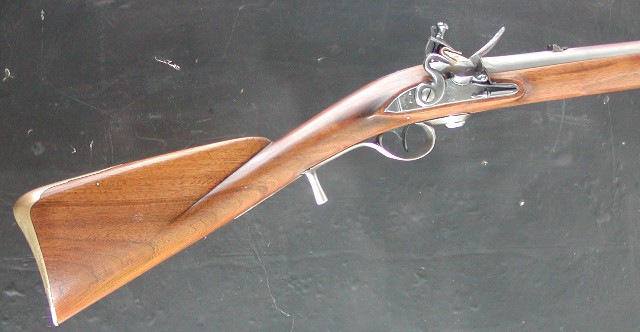
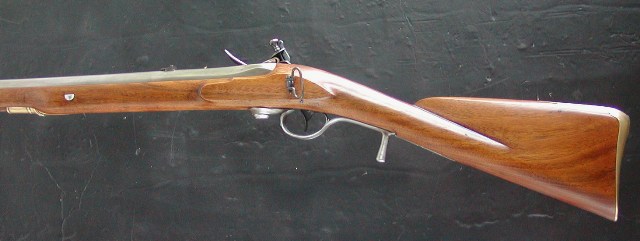





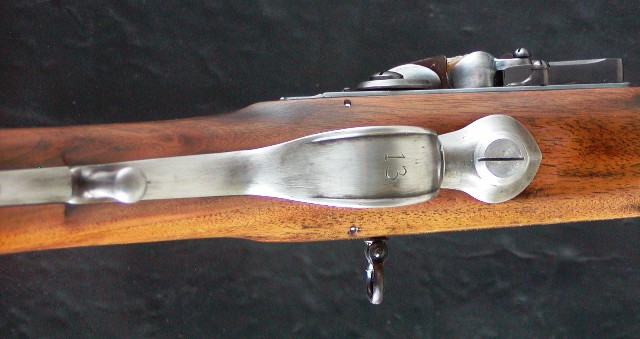

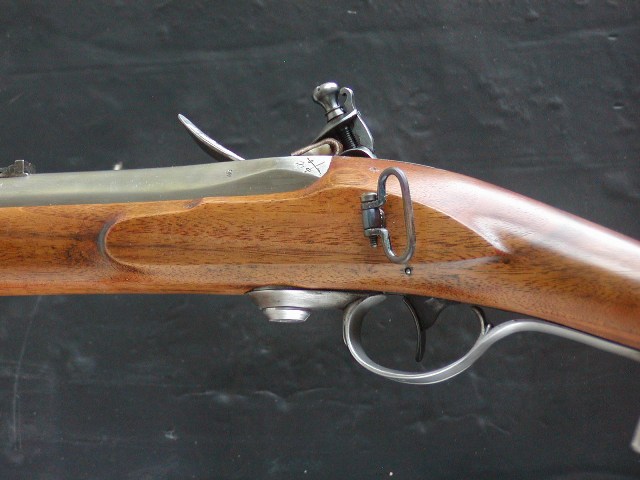
dave
The rifle is done. It came out well and next week I will test it before shipping it off. It was made from a TRS parts set including their pre-carved stock. I documented some of the travails of that stock but it all worked out. One of the last tasks is to pin the rear sling swivel stud to the stock. I used calipers to locate how far in from the side the pin should go and then eye balled the location front and back as well as the angle of the hole. The pin is a simple 5/64" diameter finishing nail. I mark the hole, then remove the stud and drill the wood so the hole just a little deeper than the bottom edge of the stud. Then I clamp the stud in place and drill it using the existing hole as a guide. Once drilled, I measure the total depth of the hole with the drill and cut the nail slightly longer than that measured depth. I discard the head of the nail and keep the shaft and point. Then I insert the nail in the hole with the stud installed, and tap it, driving the point into the wood under the stud and use a punch to tap it in flush with the wood. You only get one shot at this so your positioning and set up has to be right the first time. Once the pin is in, you cannot remove it without drilling it out. The last task will be pinning the barrel keys. They have slots and were pinned to the stock so they did not get lost. I won't do that until I've shot the rifle and assured myself they pins are working just right and are tight enough in their slots. Then I will pin them. My biggest concern is the rifle is going to the hot humid south and I worry about wood swelling. I may not pin the keys and send instructions to the owner how to pin them (it is easy) so he can test the gun in his humid environment before permanently pinning the keys. So without more blathering, hear it is.












dave
This is dazzling and rare. The owner willl be very fortunate to have had you build this masterpiece for him. Congratulations
FlinterNick
69 Cal.
- Joined
- Nov 1, 2018
- Messages
- 3,971
- Reaction score
- 3,026
A couple of things...
Firstly I have found another Ferguson in Edinburgh Castle. It is in the Museum of the Royal Scots Dragoon Guards, which are the successors to the North British Dragoons, Ferguson's original regiment. The gun is a military pattern rather than a civil one, but I need to check the markings and get a better look at it.. I have some contacts with the Regiment, so we will see...
As to Dave's stamping about.. I cannot but admire the workmanship or attention to detail.. however can I inject a note of caution about adding "proof" markings! These are still covered by existing law in several parts of the world! Proof has no date expiry, and 18th C proof marks still have legal validity. You need to be very careful adding marks that represent proof markings as it will get you into hot water in certain countrys. I know in the UK the Guardians of both Birmingham and London proof houses would take a very dim view of proof markings being added to a modern gun by anyone but them, and would pursue it through the courts. I am aware that proof markings have no relevence in the US, but they do in most of Europe and this would limit your ability to export such pieces should you or future owners wish to do so. There is a very realistic chance of any such gun being destroyed if an attempt at import was made.
I am absolutely not accusing Dave of any intent apart from trying to create an authentic representation, however there has to be a boundary between this and potential forgery. Please bear this mind when adding period markings to a modern reproduction. My practice is to mark the barrel on the underside with my name and the true date of manufacture.
... none of us are immortal!
I’ve been told the same by other’s that view my work with custom made proofing stamps i have worked on, however i think you need to look at this from a more logical perspective. Historical proof marks are in fact, historical, theyre not in use today by any governments. Proof marks are also different from other markings such as surcharges, view marks and other stamps such as recording stamps by a store keeper. We tend to generalize the term proof marks too much.
Most modern builders of historical military arms will attempt to add a stamp or two to the reproduction musket. Kit Ravensheeer, Leonard Day, John Bosch, and Jess Melot all have practiced this with their builds.
I’ve seen several of Kit Ravensheer’s Bess’s that have very oversized stamps on them, not knowing if they were done by Kit or not but original proof marks are not as large as modern stamps.
I’ve also seen French guns by Day and Bosch stamped with Charleville marked locks and St.Etienne stamped view marks on barrels, and St. Etienne marked locks with Charleville stamped view marks, this is an obvious mismatch of stamping.
Could Dave’s Ferguson be confused with an authentic original …. No Not likely ever.
In the collector’s world, various brokers and auctioneers that specialize in original guns could tell an original from a repro in a matter of minutes, sometimes seconds. The fact that only a few originals in excellent condition may exist is also a factor.
I’ve used this term before, But original Bess’s and military arms were heavily used, many look like they were raised from a shipwreck. The condition of an original vs. a repro are very realizable. Things like wood condition, shrinkage, steel patina, and just general use of the arm stand out. A new repro Ferguson or even a much less new Ferguson, could never be confused for being an original, unless it was ‘antiqued’ even then it would be an intended forgery to commit a financial crime which is traceable to its original transaction. An original military arm in excellent condition is a very rare thing, and could fetch a price upward near $25,000 for that to be a scam or forgery, a lot of people would need to be fooled, experts such as Dave, Paul Ambrose, would be watching this auction or at least looking at the specimen. A high condition high value original musket doesn’t get overlooked by many collectors.
Last year Moller’s collection auctioned, his 1763 Charleville, is one of the best condition originals with Mollers’ personal markings on them, it still sold for $13,000 with Moller’s personal stamp on the gun and there’s enough documentation of this gun to warrant its value.
As for historical proof marks being confused with modern proof marks, this would only be a relevant issue if you wanted to bring the gun to england and or sell the gun in England, the proof marks would need registration paper work to be considered authentic, again relevance, if one is going to take the gun to england, it would need to be turned over for meeting current laws.
For the average Joe that gets ripped off in an online auction, buying a repro that is thought to be an original, there’s always the risk of this happening, anyone who engages in purchasing antiques needs to really know what they’re getting into, lots of research needs to be done, if you plop down an bid on something without really asking questions or conducting diligent research, well that’s risk you take for pressing a button and these days, all it takes is a click.
Last edited:
FlinterNick
69 Cal.
- Joined
- Nov 1, 2018
- Messages
- 3,971
- Reaction score
- 3,026
Hi,
The rifle is done. It came out well and next week I will test it before shipping it off. It was made from a TRS parts set including their pre-carved stock. I documented some of the travails of that stock but it all worked out. One of the last tasks is to pin the rear sling swivel stud to the stock. I used calipers to locate how far in from the side the pin should go and then eye balled the location front and back as well as the angle of the hole. The pin is a simple 5/64" diameter finishing nail. I mark the hole, then remove the stud and drill the wood so the hole just a little deeper than the bottom edge of the stud. Then I clamp the stud in place and drill it using the existing hole as a guide. Once drilled, I measure the total depth of the hole with the drill and cut the nail slightly longer than that measured depth. I discard the head of the nail and keep the shaft and point. Then I insert the nail in the hole with the stud installed, and tap it, driving the point into the wood under the stud and use a punch to tap it in flush with the wood. You only get one shot at this so your positioning and set up has to be right the first time. Once the pin is in, you cannot remove it without drilling it out. The last task will be pinning the barrel keys. They have slots and were pinned to the stock so they did not get lost. I won't do that until I've shot the rifle and assured myself they pins are working just right and are tight enough in their slots. Then I will pin them. My biggest concern is the rifle is going to the hot humid south and I worry about wood swelling. I may not pin the keys and send instructions to the owner how to pin them (it is easy) so he can test the gun in his humid environment before permanently pinning the keys. So without more blathering, hear it is.












dave
Great job Dave ! Excellent workmanship !
Felix the Cat
40 Cal
Can I just clarify that the point I was making was that proof marks, unlike other markings found on firearms such as inspectors or view marks are still strictly covered by law. I am making absolutely no assertions that Dave or anyone else is trying to fool anyone, however the authorities in certain countries, should these firearms ever end up there, may take a different view.
I am aware that TRS reproduces inspectors marks on locks etc, but I am not aware that they have ever reproduced actual proof marks on barrels, which is the main issue, although technically breech plugs and any other pressure bearing part need to be marked as well.
The proof houses in the relevant countries have a monopoly on applying proof marks that goes back centuries and comes with heavy powers of seizure and destruction. It is very similar to the hall mark assay markings applied to gold and silver items.
In the UK it is illegal to sell a firearm at has not been subject to proof and marked as such. There is no time expiry on such markings, so an 18th C proof mark, provided the firearm remains "in proof" is still legally valid. The Proof houses have tried many times in the past to require re-proof, but have never succeeded. Old proof marks are therefore legally significant, and there needs to be protection against the use of "reproduction" proof marks, if only to prevent a seller breaking the law by selling an unproofed firearm.
My own thoughts on the matter would be to make a "blank" proof punch with the correct outline, but no detail, to indicate the presence of the proof mark, but not reproduce it in detail.
I cannot but admire the incredible workmanship of gunmakers such as Dave, but I feel that I would be remiss in not pointing out the pitfalls in reproducing proof marks. Even if there was no intention to deceive, the proof authorities can take action as it an absolute crime.
I am aware that TRS reproduces inspectors marks on locks etc, but I am not aware that they have ever reproduced actual proof marks on barrels, which is the main issue, although technically breech plugs and any other pressure bearing part need to be marked as well.
The proof houses in the relevant countries have a monopoly on applying proof marks that goes back centuries and comes with heavy powers of seizure and destruction. It is very similar to the hall mark assay markings applied to gold and silver items.
In the UK it is illegal to sell a firearm at has not been subject to proof and marked as such. There is no time expiry on such markings, so an 18th C proof mark, provided the firearm remains "in proof" is still legally valid. The Proof houses have tried many times in the past to require re-proof, but have never succeeded. Old proof marks are therefore legally significant, and there needs to be protection against the use of "reproduction" proof marks, if only to prevent a seller breaking the law by selling an unproofed firearm.
My own thoughts on the matter would be to make a "blank" proof punch with the correct outline, but no detail, to indicate the presence of the proof mark, but not reproduce it in detail.
I cannot but admire the incredible workmanship of gunmakers such as Dave, but I feel that I would be remiss in not pointing out the pitfalls in reproducing proof marks. Even if there was no intention to deceive, the proof authorities can take action as it an absolute crime.
Felix the Cat
40 Cal
Just a quick update to my posting about the Ferguson I found in the Royal Scots Dragoon Guards museum in Edinburgh Castle. It is a reproduction by Narragansett arms. Apparently, Philip Edwards of Narragansett presented it to the Museum in 1999, which was an incredibly generous act!
Edinburgh Castle therefore has TWO Fergusons! Do you think if they put them in the same display case they would breed?
Edinburgh Castle therefore has TWO Fergusons! Do you think if they put them in the same display case they would breed?
Similar threads
- Replies
- 1
- Views
- 1K
- Replies
- 5
- Views
- 3K
- Replies
- 50
- Views
- 10K
- Replies
- 11
- Views
- 3K




